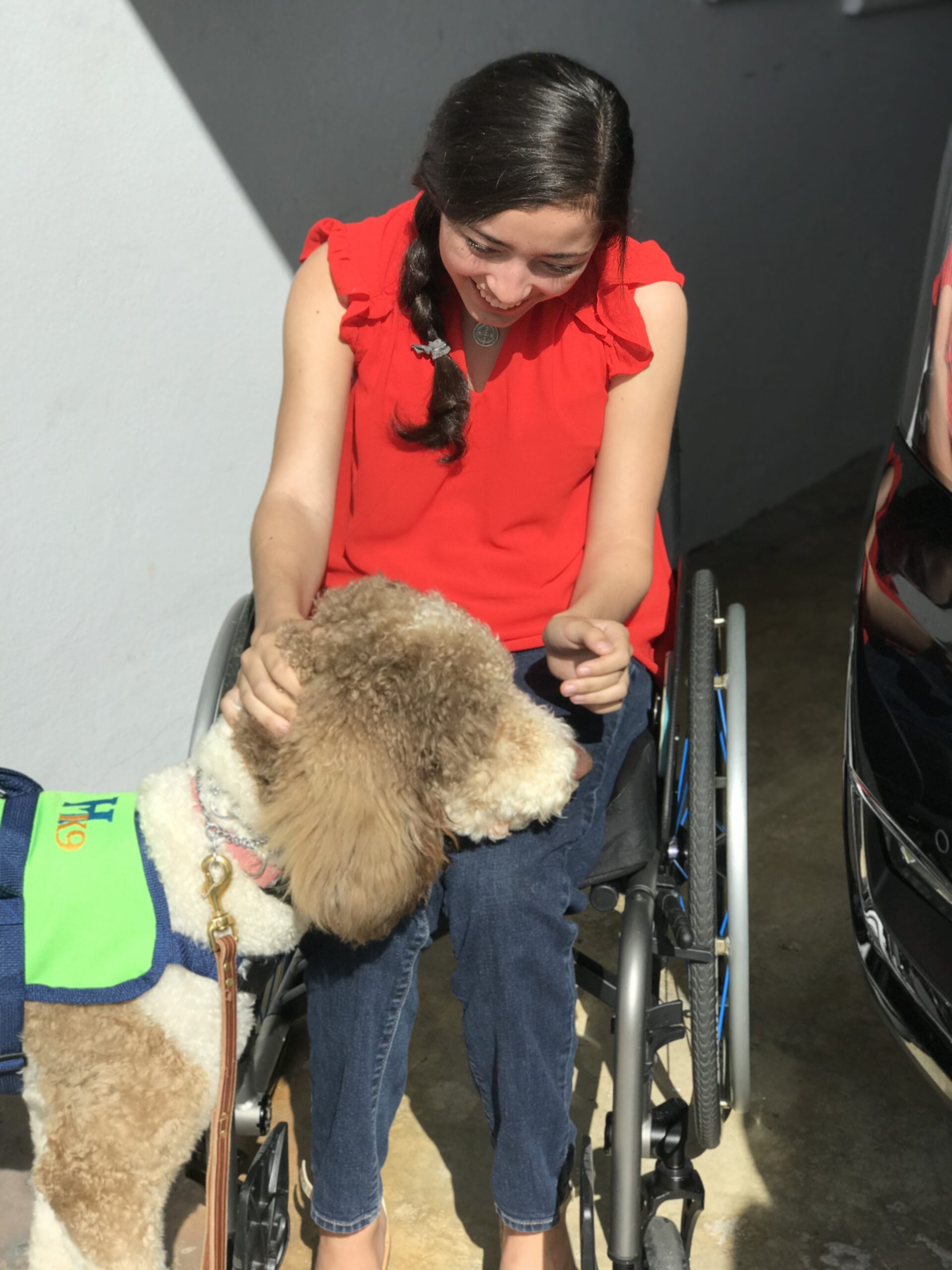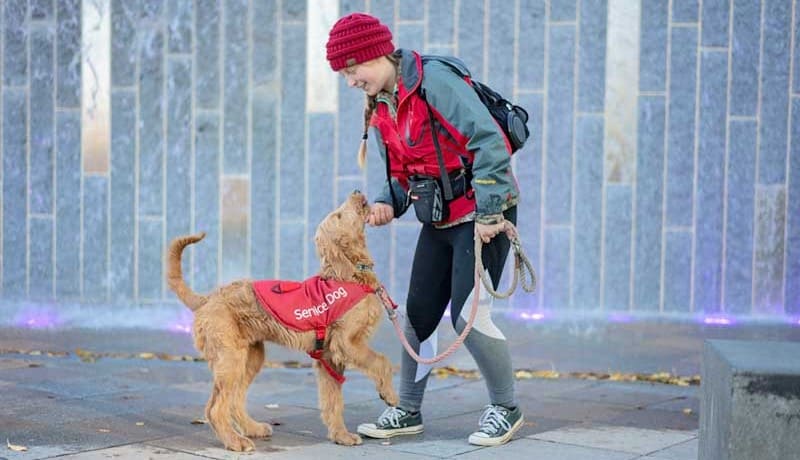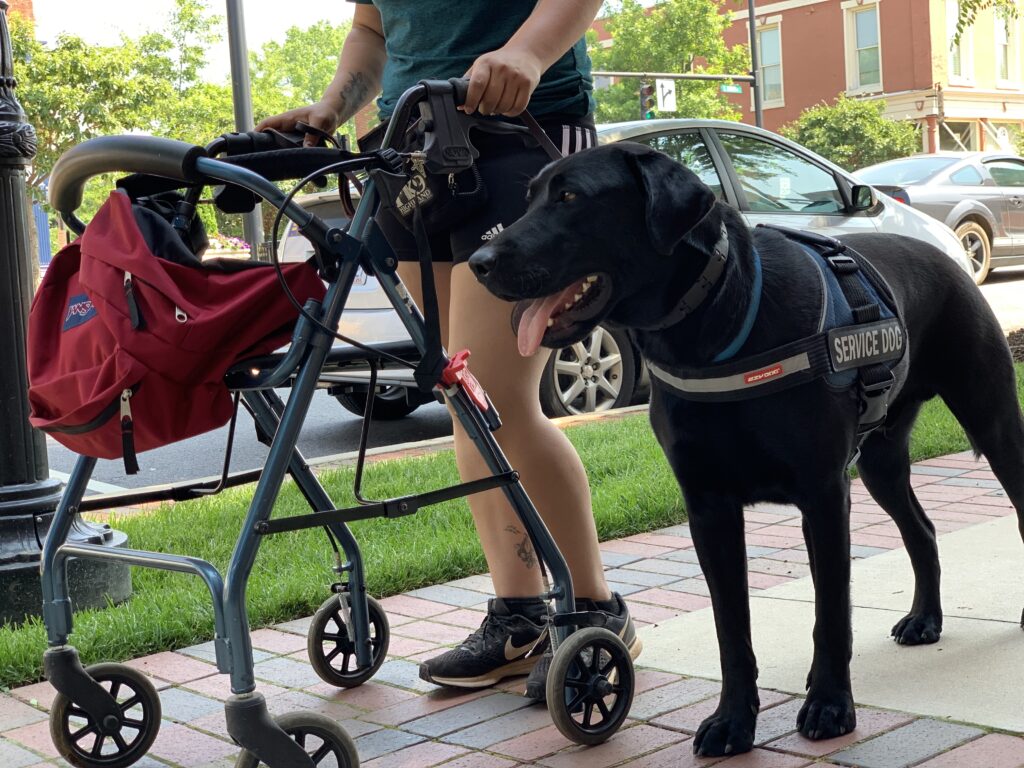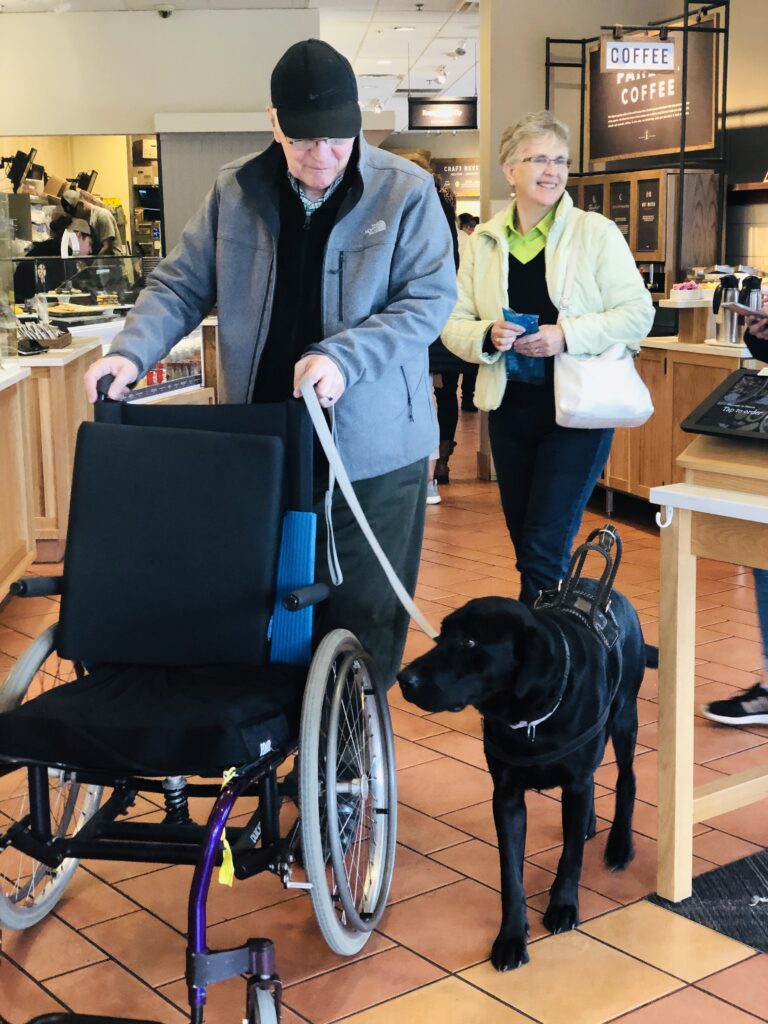Mobility Assistance Dogs
Offering Independence AND FREEDOM

A Mobility Assistance Dog can offer a wide range of support for individuals requiring additional help with movement in their daily lives. These incredibly trained dogs are able to help people with disabilities or injuries which prevent them from carrying out everyday tasks.
You might be surprised at the range of tasks a mobility assistance dog can perform. From retrieving dropped items to bracing during transitions, the assistance of mobility service dogs opens up an entirely new world of independence and confidence for their handlers.
To provide the necessary stability, a mobility assistance dog is usually a medium-to-large size dog breed. These dogs are trained to perform the tasks required to assist their handlers and improve their quality of life.
Due to the wide range of individual needs and specifics, these service dogs can be custom-trained to focus on the tasks necessary to improving the quality of life for individuals looking for mobility assistance. These amazing dogs are trained to turn lights on and off, help individuals in and out of a wheelchair and even open doors.
In addition to the physical benefits a mobility assistance dog can provide, dogs also provide emotional and psychological benefits as well.
The Benefits of a Mobility Assistance Dog
For people with disabilities, a mobility assistance dog can offer numerous benefits to their owners – and their families.
These dogs are trained to perform specific tasks to make everyday life easier. Not only are they accomplished at providing support for mobility assistance, but they also offer peace of mind and reassurance for concerned family members.
Some of the benefits of having a Mobility Assistance Dog include:
Increased Independence
With the aid of a constant companion trained to assist with difficult tasks, mobility assistance dog handlers report that greater independence was achieved after the addition of their service dog. Self-sufficiency can be possible for many with the reliability of a mobility service dog.
Heightened Confidence
The overall confidence of many mobility assistance dog handlers is raised as a direct result of being capable of greater independence. Daily use of their service dog partner creates a dependable connection built on trust and experience. In many environments, dogs have been found to offer unique support for their owners. Additional confidence is gained from this working relationship.
Expanded Activity and Overall Better Health
To maintain effective performance of their trained tasks, service dogs must undergo daily maintenance training and continued socialization. In order to keep a mobility assistance dog in great physical and mental shape, it is important for the handler and service dog to go new places and experience new things together. The addition of a mobility assistance dog brings more opportunities to stay active and get out in your community.
Enhanced Feeling of Security
It is common for people with disabilities to feel wary of being taken advantage of when alone in public situations or even at home. The presence of an assistance dog can often provide a sense of security, offering company which can help ease the mind. This also provides a level of reassurance for family and friends.
"Our new service dogs will definitely help my daughters."

What Does Mobility Assistance Mean?
Learn more about what a mobility assistance dog does, and how they help their handler to overcome movement difficulties in their everyday lives.
Also referred to as wheelchair assistance dogs or mobility service dogs, a mobility assistance dog provides support for their handler in common daily activities. Over the years, we have trained numerous dogs to assist people who suffer with physical disabilities or have sustained injuries which has restricted their movement. The support these service dogs can offer is an invaluable benefit to their handler.
With our vast experience, we are able to train a mobility assistance dog to perform tasks which are customized to the needs of the handler. We understand the needs vary from person to person, and the dog must be able to perform these tasks reliably and effectively. Our dogs are always trained with their handler in mind.
In addition, we understand that situations change over time. Sometimes, the severity or specifics of a diagnosis can change, which can change the nature of the mobility assistance required. We make it a priority to stay in close contact with the handler and their families at all stages of the process to ensure we offer an unparalleled level of support and help.
Tasks & Training
A mobility assistance dog can be trained to perform many essential tasks which offer vital assistance to their handlers.
Our trainers have years of valuable experience when it comes to training service dogs. Every task is trained to suit the individual needs of the owner and their families.
Here are a few examples of typical tasks our mobility assistance dogs are trained to perform.

Retrieving Dropped Items
Mobility assistance dogs can be trained to identify fallen objects and return them to the owner. This helpful task can aid individuals who require the use of a wheelchair, a walker or crutches, providing assistance to those who find difficulty reaching dropped items.

Retrieving Specific Objects
Mobility assistance dogs can be trained a cue to retrieve specific objects from familiar spots. Examples of these objects include a cell phone, medical bag, certain mobility devices or keys – but if a dog can fit it safely in their mouth and carry it, our service dogs can usually be trained to retrieve it.

Bracing/Stability Assistance
Our dogs are trained to offer balance and a sturdy platform for bracing when their owner is transitioning from a wheelchair, scooter, or other mobility device to a bed, car, a seat, etc. Using a specially designed mobility harness, the dog can assist with adjustments, walking short distances, and more.

Opening and Closing Doors
Whether it’s a kitchen cabinet, a refrigerator, a bedroom door or a dresser drawer, mobility assistance dogs can open doors of many kinds, and then close them after the handler is finished. In addition, these dogs can also be trained to hold doors open for the wheelchair to go through.

Pressing Buttons For Automatic Doors
Assistance dogs can be trained to press the automatic door button as their handler walks into a public building. This removes the responsibility from the handler and makes the experience far more pleasant for the handler.

Flipping Light Switches
From across the room, an assistance dog can turn light switches on or off on command. This makes morning routines and room entrances much easier in the day to day life of an individual in a wheelchair.
Who Can Benefit From a Mobility Assistance Dog?
The latest figures from the CDC indicate that one in four Americans have a disability. The most common type of disability affects mobility – including walking or climbing stairs.
Mobility assistance dogs are particularly useful for anyone suffering from the following disabilities, injuries or ailments:
- Spinal cord injury
- Arthritis
- Muscular dystrophy
- Brain injury
- Cerebral palsy
- Multiple sclerosis
- Vertigo
- Impaired balance
This list is definitely not exhaustive. We have helped countless individuals by training mobility service dogs. Our service dogs are trained specifically for the needs of their handler. In summary, if you have trouble with movement and it affects how you live your day-to-day life, a mobility service dog can be trained to help you to overcome those difficulties.

"I can't imagine my life without him."

Which Breeds Make Good Mobility Assistance Dogs?
Find out which dog breeds are commonly used for mobility assistance – and why.

Over the years, we have trained numerous dog breeds to perform mobility assistance tasks. Service dogs have to be capable of performing the tasks they are being trained for, and that is no different with a mobility assistance dog.
Obviously, for mobility assistance, a service dog needs to be able to help their owner balance and provide stability. For this reason, assistance dogs for mobility are typically medium or larger breeds, such as Golden Retrievers, Labrador Retrievers, or Poodles or Doodles. Other breeds or mixes/crosses of these breeds can also be trained.
In addition to the size and build of the dog, the mobility assistance dog needs to have a reliable, calm temperament. Our dogs are trained to perform tasks in a variety of environments and under different types of stimuli.
Do I Qualify For a Mobility Assistance Dog?
Learn more about our application process for mobility service dogs. Our team is experienced and has helped countless individuals over the years.
If you are interested in starting a new journey and working relationship with a mobility assistance dog, please begin the application process by submitting a preliminary application.
After the review of your application, you will be invited to have a phone consultation with a service dog trainer to discuss your application, specific needs, and possible tasks a dog could be trained to assist you. During the phone consultation, the trainer may ask that you supplement your application with additional information to aid the trainers in their decision of the correct methods of training your specific service dog.
After the approval of your complete application, you are admitted in to our service dog program. At this time, you will be sent a Training Agreement and Task/Performance Addendum. These must be signed and returned, along with a deposit of $2500 to hold your spot on our waiting list.
Learn More About Service Dogs
The service dog community has become vast and diverse in recent years. Now more than ever, families looking into autism service dogs are able to easily find an array of information at their fingertips. However, many have found that a lot of this information is confusing or even conflicting. So where do you start? For information on service dogs, we suggest becoming familiar with the definition, guidelines, and rules available for review by the Americans with Disabilities Act. This information is straight from the source and a great option for educating yourself on the subject of service dogs.

Contact us today!
Interested in adding a Mobility Service Dog to your family? Have questions about the process? Contact us today and a member of our specialist team will reach out to you!
There are a number of ways to get in touch. Whether it’s telephone, email, social media or our contact form below, we’d love to hear how we can help you.
- 704.500.8281
- info@autismassistancedog.com
- Check us out on Facebook